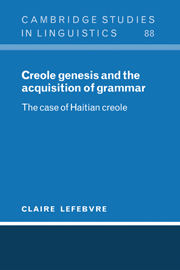Book contents
- Frontmatter
- Contents
- Tables
- Preface
- Abbreviations
- 1 The problem of creole genesis and linguistic theory
- 2 Cognitive processes involved in creole genesis
- 3 The research methodology
- 4 Functional category lexical entries involved in nominal structure
- 5 The preverbal markers encoding relative Tense, Mood and Aspect
- 6 Pronouns
- 7 Functional category lexical entries involved in the structure of the clause
- 8 The determiner and the structure of the clause
- 9 The syntactic properties of verbs
- 10 Are derivational affixes relexified?
- 11 The concatenation of words into compounds
- 12 Parameters
- 13 Evaluation of the hypothesis
- 14 Theoretical consequences
- Appendices
- Notes
- References
- Index of authors
- Index of languages and language families
- Index of subjects
3 - The research methodology
Published online by Cambridge University Press: 23 November 2009
- Frontmatter
- Contents
- Tables
- Preface
- Abbreviations
- 1 The problem of creole genesis and linguistic theory
- 2 Cognitive processes involved in creole genesis
- 3 The research methodology
- 4 Functional category lexical entries involved in nominal structure
- 5 The preverbal markers encoding relative Tense, Mood and Aspect
- 6 Pronouns
- 7 Functional category lexical entries involved in the structure of the clause
- 8 The determiner and the structure of the clause
- 9 The syntactic properties of verbs
- 10 Are derivational affixes relexified?
- 11 The concatenation of words into compounds
- 12 Parameters
- 13 Evaluation of the hypothesis
- 14 Theoretical consequences
- Appendices
- Notes
- References
- Index of authors
- Index of languages and language families
- Index of subjects
Summary
This research was designed to test how the processes hypothesised to play a role in creole genesis work on the basis of Haitian creole (see Lefebvre 1986, 1993a), the classic example of a radical creole (see Bickerton 1984). Since any account of the genesis of Haitian creole must be compatible with the history of Haiti, the research included a historical study. The first section of this chapter is dedicated to the major findings of this study, designed to establish when Haitian creole was formed and the characteristics of the Haitian population during that period. Section 3.2 discusses the typological features of the languages spoken in Haiti during the period when the creole was formed, i.e. West African languages and French. Section 3.3 considers what French data the creators of Haitian were exposed to. The linguistic test of the hypothesis rests on a detailed comparison of the lexical entries of the creole with those of its contributing languages. Section 3.4 describes the linguistic test we were able to do within the limits of the project research and section 3.5 discusses how the theory can be falsified. Section 3.6 provides information on the data on which the analyses presented in this book are based. Section 3.7 introduces how the data and analyses are presented.
The economy, demography and linguistic diversity of early Haiti: 1659–1740
The careful and abundant work by historians on the slave trade and the ethnic composition of particular colonies does not provide precise enough information on the external factors that prevailed in the early history of Haiti for linguists to determine when Haitian creole was formed and who was there at the relevant time (see Filipovich 1986; Lefebvre 1993a).
- Type
- Chapter
- Information
- Creole Genesis and the Acquisition of GrammarThe Case of Haitian Creole, pp. 52 - 77Publisher: Cambridge University PressPrint publication year: 1999

